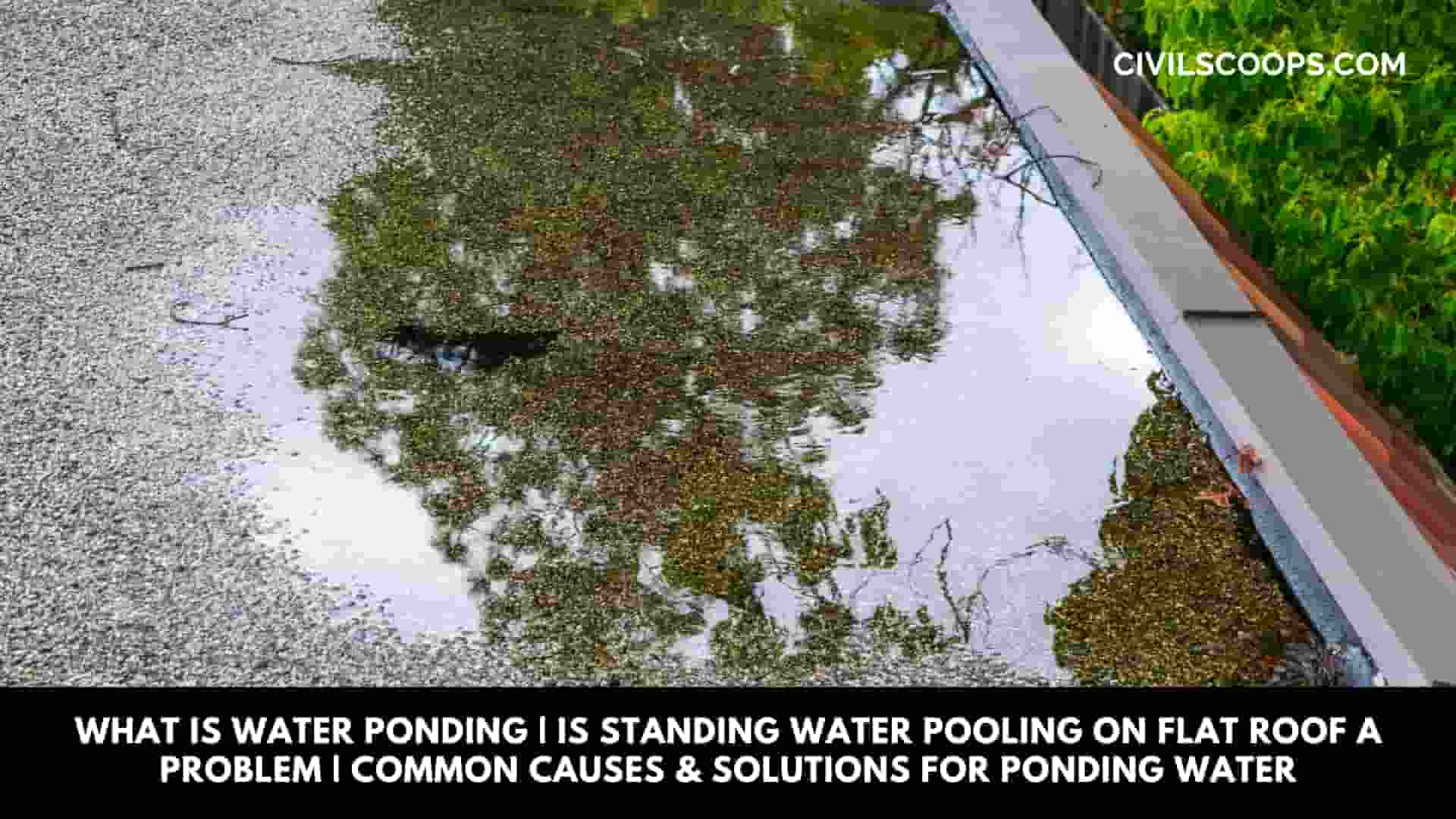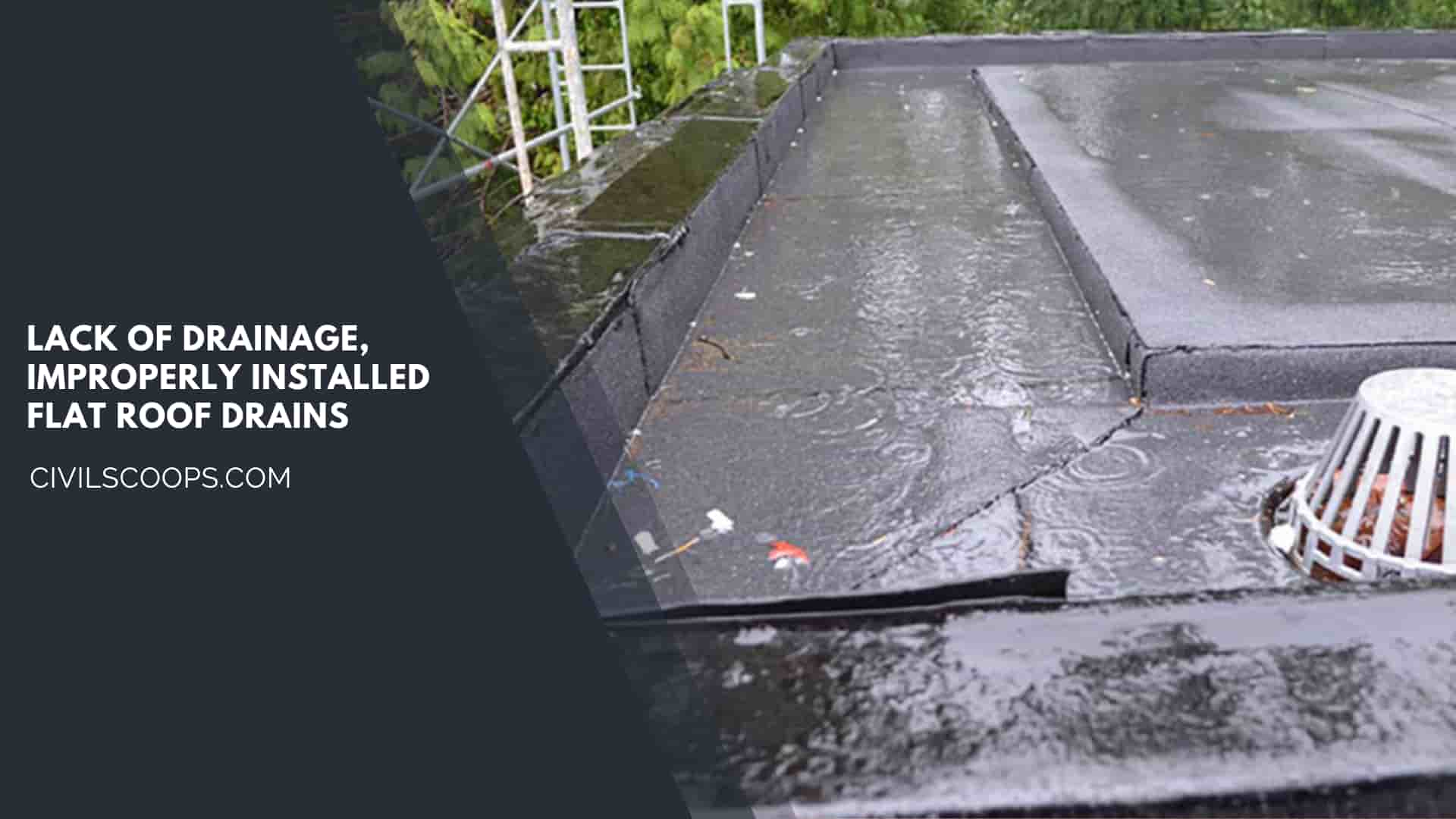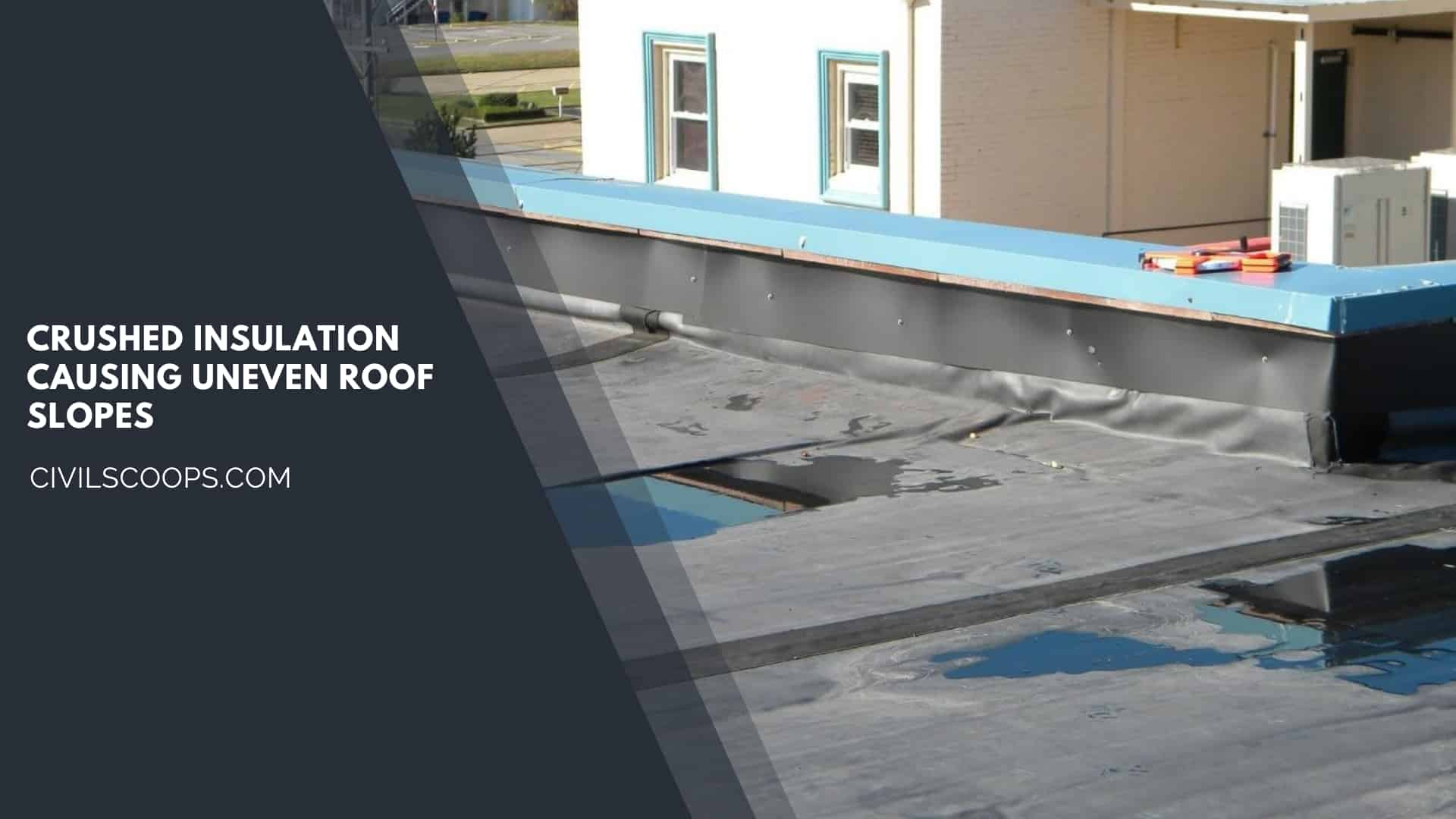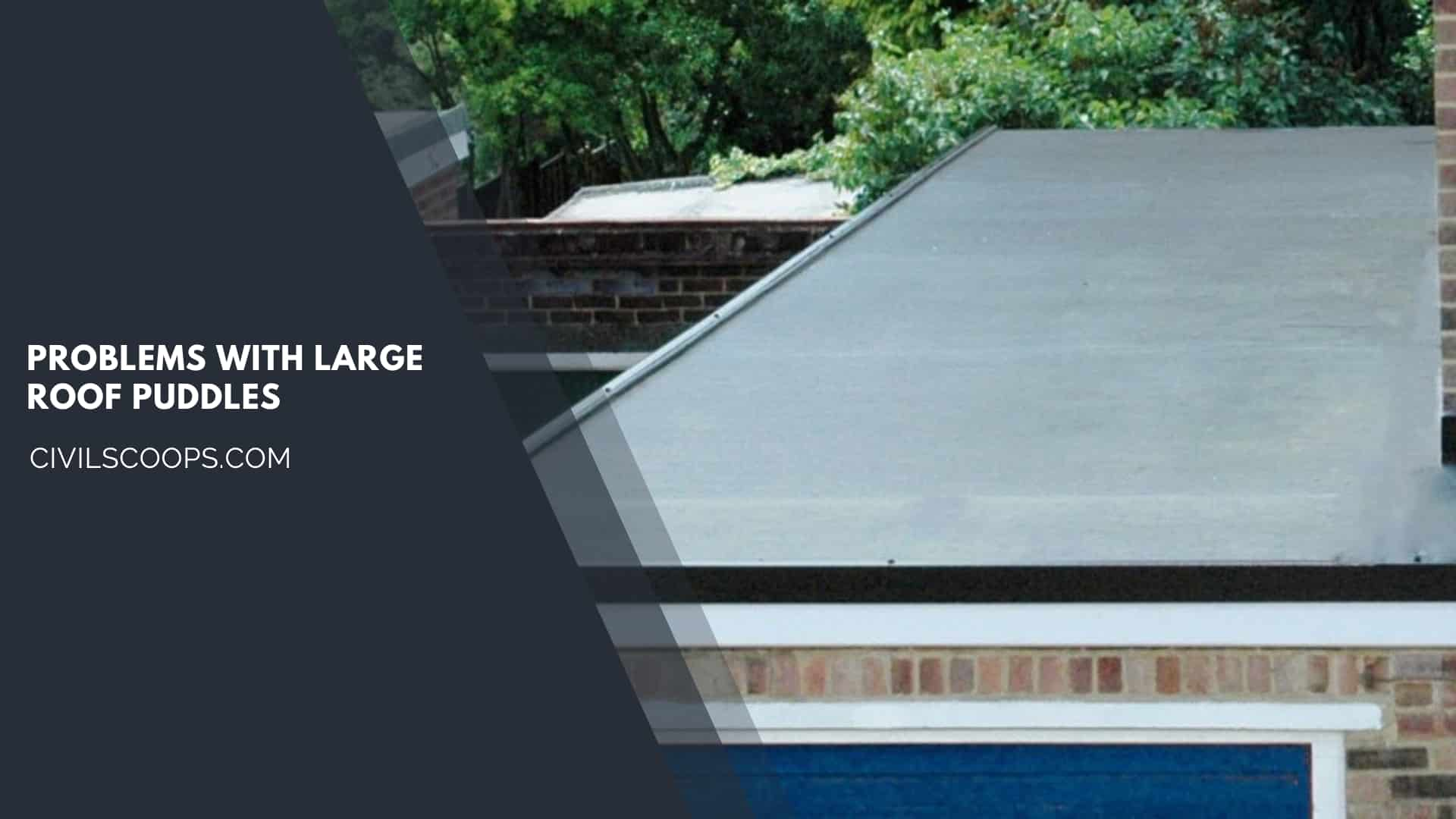What Is Water Ponding | Is Standing Water Pooling on Flat Roof a Problem | Common Causes & Solutions for Ponding Water

Table of Contents
What Is Water Ponding?

As in Construction Industry, National Roofing Contractors Association(NRCA) described Water Ponding as “Water which remains over the roof surface for more than 48 hours, after the termination of recent rain event”
So in simple words, Water Ponding can be explained as a major accumulation of water over a flat roof, which can be caused due by various reasons, and can result in a major drawback with proceeding time.
Is Standing Water Pooling on Flat Roof a Problem?

From ancient civilizations, people tended to shelter themselves from natural calamities, such as rain, thunderstorms, cyclones, and many others. At first, they accommodated themselves using caves built of rock.
Slowly with time, we developed an aesthetic sense, which helped us to improve our living quality as well. Thus caves of rock became transformed into huts, which also transformed into houses with concrete roofs.
As per the research papers of many designers, and also as per the National Building Code, Roofs can be of different types, the selection of which depends upon, the type of house, architectural consideration, and primarily, the weather or climate of the particular topographic area.
As the climate differs, the selection of the type of roof also defers, such as, in heavy rainfall or snowfall regions, a Sloping or pitched roof may be considered(having a slope of the roof of more than 10°, is called a high slope-pitch roof), to drain the water constantly thus preventing any stipulation of water over the roof.
In the case of a flat roof, the slope of the roof is far below 10° which can be used in topographic areas having low to medium range rainfall.
This type of roof is very easy to construct and also have a pleasant look, this type of roof is widely adopted in moderate climatic condition, which prevails around eight months in most of the places in India.
Although it has its reasons, as rainfall occurs mostly in monsoon time, one big question still prevails, “Does water logging occur on flat roofs?
Can this be considered a problem?”; to answer this, some basic knowledge on waterlogging needs to be gathered as follows-
Also Read: Different Types of Roofing Materials | What is Roof Covering
Common Causes & Solutions for Ponding Water

1. Water Ponding: Causes
As already mentioned earlier, Flat roofs have a slope very less than 10°(or very precisely, less than 2°). Thus to drain the water stored at the top of the roof surface, due to rain, mostly gutters, internal drains, or Water Pipes(having a common diameter of 100mm) are installed at the edges of the roof.
The number and location of fixing of the rainwater pipe are generally determined by design, as well as the layout that can provide the most effective type of drainage.
effective may be due to the designer’s lack of capability, or due to the sudden change of climate, this can be proved ineffective. Thus as a failure of the function of the rainwater pipe, the water remains logged in the roof for a long time, resulting in water bonding.
Water ponding can also be witnessed on roads, having inadequate design drainage, logged into the surface after severe rain, which can fail in the roads.
In our modern civilization, many high-rise buildings can be witnessed. As the intensity of rain is very high and concentrated at buildings having more height, many a time, this becomes a major factor in water bonding.
2. Water Ponding: Effect
The effect of water ponding can be very dangerous if left untreated. Whenever water accumulates at the top of the roof, slowly with time, it dampens that particular portion of the roof, as well as its surroundings, due to the capillary flow of water.
Starting with roofs, the capillary action of water in the walls can also be shown, resulting in peeling and discoloration of paints as well as plaster, resulting in the dampness of the wall as well.
Thus to rectify this, one needs to treat the roof using waterproofing chemicals and refurbish the walls as well, which can be very costly.
Accumulation of Insects, such as fungus, and moss can be found growing in the walls due to the capillary action of rainwater.
Thus one needs to adopt anti-fungal treatment for roof and wall as this adds to the expense.
3. Water Ponding: Prevention
To prevent water bonding at the top of the roof surface, drainage design should be done accurately by experienced designers and checked thoroughly to rectify any unwanted mistakes.
The number and the location of the rainwater pipes, gutters, and stormwater drains are to be accurately determined depending upon the exact pitch of the roof; so that water gets drained out immediately after dropping at the roof surface.
Many a time, some waterproofing treatment is done after the construction of the roof. This protects the roof from any adverse effects of waterlogging and also increases the longevity of the roof. It’s not too expensive, but adopting it can yield very good results for the roof.
Also Read: How to Reduce Construction Cost (Tips)
Rubber Roofs with Multiple Layers For Water Pounding

Apart from Asphalt roofing, another widely adopted roofing system for flat or low slope-pitch roofs is membrane roofing. In this type of roofing, the primary material adopted is a membrane, which is generally polymer-based material, which is why this type of roofing is denoted as “Rubber Roofing” as well.
Some materials used for manufacturing membranes are Neoprene, PVC(Polyvinyl Chloride), EPDM, Polymer modified bitumen, etc. It is very much similar to the Asphalt Roof, where it is applied in large sheets over the roofs, to resist the permeation of water.
In the case of this type of roof, generally, 2-3 layers of the membrane are implemented as this will give more resistance to water ponding as compared to the application of a single layer of the membrane.
One of the biggest advantages of membrane roofing is that it is very cost-effective and installation cost is also low as well. Thus such a roofing system will not incur much money, in return, it’ll provide longevity to the roof. The age of this type of roofing system can vary from 20 years to 35 years.
Importance of Roofing Material For Water Ponding

Thus from the above, The importance of roofing material can be pointed out as
The roofing material protects the roof from the adverse effects of heavy rainfall, and snowfall, thus increasing the durability of the roof as a whole, Roofing materials protect the roof in case a fire breaks out, which guards the roof against being damaged.
A wood shingle roof can be molded into any shape thus increasing the aesthetic appearance of the roof to the tenants. Many a time, roofing materials dissipate the heat which often gets absorbed by the bare roof.
Thus roofing material is indirectly responsible for a cool and pleasant atmosphere on the inside, while extreme temperature avails on the outside.
Quality Vs Craftsmanship
What is the Quality of Roof Material For Water Ponding?: In one sentence, Quality is an integral property of an individual material, which ensures that the material is sound, durable, structurally stable, and can suitably used for the function as per its technical specification.
What is Craftsmanship in Roof Material For Water Ponding?: Craftsmanship is the procedure of erecting something, with a creative solution, so that it can give a very pleasant look as per the owner’s or clients’ requirements.
The terms quality and craftsmanship are very much related and craftsmanship is the procedure of beautifully erecting something, and quality is the way of ensuring its structural integrity…
In many of the roofing systems, such as wood shingle roofs, the craftsmanship involved is very high. One needs to require high skills to mold the woods in a desirable shape and to give beauty to the roof as per the owner’s requirement.
On the other hand, one needs to ensure the quality of the wood, the structural design, and the dead & live loads applied on the roof, should also be taken into consideration.
Achieving high quality requires, a better quality of wood to be used, which also, in turn, affects the craftsmanship as a whole. Thus Quality and craftsmanship are completely interdependent.
The quality of the material has to be checked before starting the work. When the quality is ensured, only then craftsmanship starts the work. Thus for craftsmen, quality is a pre-inspection procedure, while for quality, craftsmanship is the actual product.
Lack of Drainage, Improperly Installed Flat Roof Drains

As already mentioned earlier, design is the primary factor on which the whole water bonding factor depends. Whenever there is the unavailability of proper design, the numbers and locations of rainwater pipes and pipe puddles become inadequate for drainage.
Thus, a lack of drainage occurs. Improperly installed flat roof drains can also be a factor driving the lack of drainage. To prevent that, the design should be made correctly and checked thoroughly.
In case of inadequate design, many a time protective courses (maybe a layer of screed concrete) are provided over the roof along with a corrected design to properly drain rainwater. In that case, no other protective or waterproofing roofing material should not need to be implemented.
Also Read: What Is Mansard Roof | Mansard Roof Replacement Cost | Advantages and Disadvantages of Mansard Roof
Crushed Insulation Causing Uneven Roof Slopes

As in the case of modern houses, mostly concealed conduit wiring is being adopted. In that case, many a time, it happens that the insulation below the roof level becomes crushed due to high live load over the flat roof surface. In that case, the roof slopes can get uneven causing the problem of water ponding and waterlogging.
Apart from the uneven roof slopes, crushed insulation even produces more heat inside the house, and correspondingly consumes more energy. Thus in such a situation, the damaged insulation needs to be corrected as soon as possible.
Problems with Large Roof Puddles

Many times, large roof puddles are installed to quickly drain water. Whenever roof puddles are located at unwanted locations, such as the center of the roof, it accumulate water thus resulting in water bonding.
Thus whenever roof puddles are installed, it needs to be ensured that they are placed at the right location of drainage, and will not pose a serious problem regarding drainage. The number of roof puddles shall need to be ensured as well.
[su_box title=”FAQ” style=”default” box_color=”#333333″ title_color=”#FFFFFF” radius=”3″ class=”” id=””]
Ponding Water on Flat Roof
Ponding is when water collects in puddles on the roof instead of draining off in a timely manner. Homeowners may think this small amount of water is harmless, but ponding tends to get worse over time and can have a negative impact on the roof and your whole home.
What Is Water Ponding?
Water ponding is the accumulation of water on flat surfaces such as slab-on-grade, flat decks, driveways or balconies. This can occur due to water seeping upward from inside (or below) the surface, or its source can be external, such as rainwater.
Water Pooling on Flat Roof
Ponding is when water collects in pools on a flat roof after a period of heavy rain and doesn’t drain off once the rain has stopped. Whilst brief and occasional ponding is acceptable on a flat roof, regular or long-lasting ponding could be an indication that there is an issue with the roof that needs to be addressed.
Water Ponding
Ponding water is defined as the water which remains on a roof 48 hours or longer. Water may accumulate on a low slope roof due to rain, snow or runoff from rooftop equipment. Ponding water can have major negative consequences, regardless of the type of roofing system.
Is Rolled Roofing Any Good?
While rolled roofing is cheap and easy to install, its resale value is perilously low when it is used as roofing on occupied structures. Rolled roofing is best installed on unoccupied structures, such as sheds, shops, garages, and other outbuildings.
Is Ponding on a Flat Roof Normal?
While some small and short term ponding, especially in heavy rains can be normal, any ponding that doesn’t evaporate within 48 hours is a cause for concern and should be evaluated by a licensed roofing contractor with experience working with complex flat roofing systems.
Roof Ponding
Ponding is the (typically) unwanted pooling of water, typically on a flat roof or roadway. Ponding water accelerates the deterioration of many materials, including seam adhesives in single-ply roof systems, steel equipment supports, and particularly roofing asphalt.
Ponding on Flat Roof
There are many reasons for water ponding on a flat roof, from the incorrect design of roof falls and insufficient slope, degrading materials causing roof sagging to drainage issues and build-up of silt on the roof surface.
Ponding Water on Flat Roof Solution
Add Additional Drains
If interior plumbing can be added easily, installing additional drains is one of the easiest and most cost-effective solutions to ponding water on flat roofs, especially if ponds are concentrated in just a few areas.
Flat Roof Puddling
Flat roof ponding is when water pools on your roof. This usually occurs after a storm or heavy rain, or when the snow melts.
How to Prevent Ponding on Flat Roof?
To stop water pooling on a flat roof, do the following:
- Flush drains of debris like dirt, branches, and twigs.
- Add more drain lines.
- Use a roof plaster to direct water toward the drains.
- Install roof crickets.
- Perform regular inspections and maintenance.
Flat Roof Ponding Solutions
To stop water pooling on a flat roof, do the following: Flush drains of debris like dirt, branches, and twigs. Add more drain lines. Use a roof plaster to direct water toward the drains. Install roof crickets.
Remedies for Water Ponding on Flat Roof
- Identify Problem Areas. While flat roofs should be, as they sound, flat, that doesn’t mean they don’t have problem areas.
- Check Your Drainage.
- Add More Drains.
- Install Roof Crickets.
- Re-Do The Coat Of Your Roofing System.
Cost to Repair Flat Roof Ponding
A flat roof costs between $4,500 and $14,000 to install, per 1,000 square feet of roof. The average cost to install a flat roof is $9,250.
[/su_box]
[su_note note_color=”#F2F2F2 ” text_color=”#333333″ radius=”3″ class=”” id=””]
Like this post? Share it with your friends!
Suggested Read –
- Types of Wooden Beams
- Introduction to Stair Landing | What Is Stair Landing | Stair Landing Dimensions
- Water Leakage from Ceiling | Water Leakage from Ceiling | How to Stop Water Leakage from Ceiling
- What Is Floating Slab | Floating Slab Construction | How to Build a Floating Slab | Advantages & Disadvantages Floating Slabs
- What Is Cedar Wood | Is Cedar a Hardwood | Uses of Cedar Wood | Types of Cedar | Red Cedar Wood | Facts About the Cedar Tree
[/su_note]
Originally posted 2023-08-28 11:01:32.
